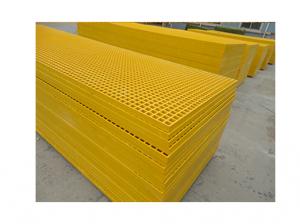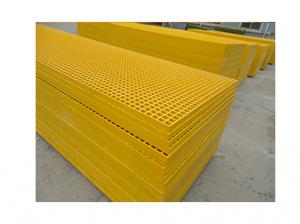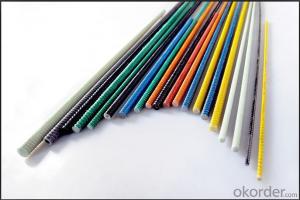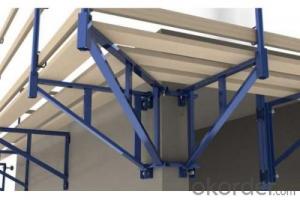FRP Molded Grating, Fiberglass Grating, Plastic Grating Floor with Modern Color and Type
- Loading Port:
- China main port
- Payment Terms:
- TT or LC
- Min Order Qty:
- 500 m²
- Supply Capability:
- 10000 m²/month
OKorder Service Pledge
OKorder Financial Service
You Might Also Like
FRP Molded Grating is a structural panel which uses high-strength E-Glass roving as reinforcing material, thermosetting resin as matrix and then casted and formed in a special metal mold. It provides properties of light weight, high strength, corrosion resistance, fire resistance and anti-skid. FRP Molded Grating is widely used in oil industry, power engineering, water & waste water treatment, ocean survey as working floor, stair tread, trench cover, etc. and is an ideal loading frame for corrosion circumstances.
Feature
Corrosion Resistance
Fire Resistance
Light Weight & High Strength
Safety & Anti-slip
Electrical Insulating
Aging Resistance
Specification
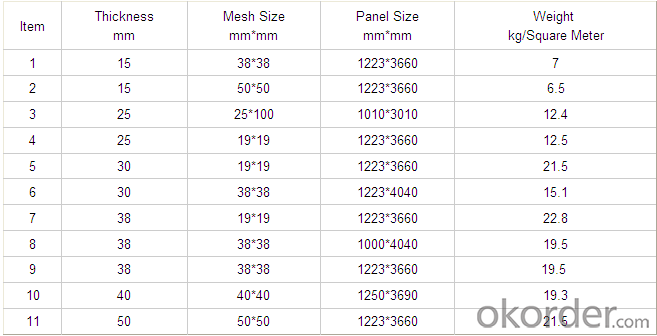
Advantage
coated with prevent aging layer
excellent insulating performance
no maintenance
high strength
long service life
easy installation
Application
Power plants, substation equipment enclosures, antimagnetic, anti-static,to prevent small animals into the equipment failure, as there is electricity facilities and without power interval intervals.
- Corrosive chemical industry equipment around the fence
All kinds of building maintenance section
FAQ
1. How about the documents after shipment?
After shipment, we ll send all original documents to you by DHL, including Packing List.Commercial Invoice, B/L, and other certificates as required by clients.
2. How is the package?
Usually, we arrange the standard out-package for exporting.
FACTORY
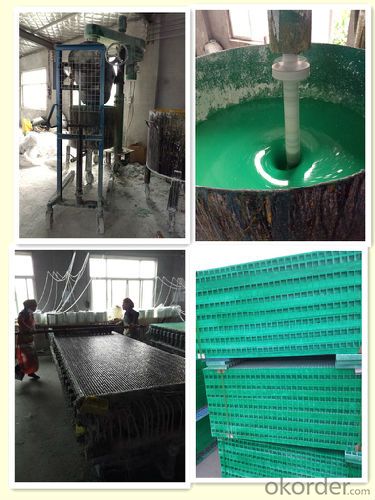
- Q:How do FRP pultrusion profiles compare to fiberglass reinforced panels (FRP)?
- FRP pultrusion profiles and fiberglass reinforced panels (FRP) are both commonly used materials in various industries due to their high strength and durability. However, there are some notable differences when comparing these two FRP products. 1. Manufacturing Process: FRP pultrusion profiles are created through a continuous pultrusion process, where fibers are pulled through a resin bath and then cured using heat or ultraviolet light. This results in a solid and uniform profile with consistent mechanical properties. On the other hand, fiberglass reinforced panels are made by combining layers of fiberglass mat and resin, which are typically molded or pressed together. This process can sometimes result in variations in thickness and mechanical properties across the panel. 2. Structural Strength: FRP pultrusion profiles are known for their exceptional strength-to-weight ratio. The continuous fiber reinforcement used in pultrusion provides high stiffness and load-bearing capacity, making them suitable for structural applications. Conversely, while fiberglass reinforced panels are also strong, they may not possess the same level of structural integrity as pultrusion profiles due to the potential for variations in resin content and fiber distribution. 3. Design Flexibility: FRP pultrusion profiles offer greater design flexibility compared to fiberglass reinforced panels. The pultrusion process allows for the incorporation of various shapes and configurations, such as I-beams, angles, tubes, and custom profiles. This versatility enables engineers to tailor the profiles to specific project requirements. In contrast, fiberglass reinforced panels are typically limited to flat or slightly curved surfaces and do not provide the same level of customization. 4. Surface Finish: FRP pultrusion profiles often have a smooth and consistent surface finish due to the pultrusion process. This makes them more aesthetically appealing and suitable for applications where appearance is important. Fiberglass reinforced panels, on the other hand, may have a textured or uneven surface, which can impact their visual appeal in certain applications. 5. Cost: When comparing costs, FRP pultrusion profiles are generally more expensive than fiberglass reinforced panels. The pultrusion process requires specialized equipment and has higher manufacturing costs. Fiberglass reinforced panels, on the other hand, have lower production costs due to their simpler manufacturing process. However, it is important to consider the specific application requirements and long-term performance when evaluating the cost-effectiveness of these materials. In summary, FRP pultrusion profiles and fiberglass reinforced panels have their own unique characteristics and advantages. The choice between the two will depend on factors such as structural requirements, design flexibility, surface finish, and cost considerations.
- Q:How do FRP pultrusion profiles handle compression loads?
- The unique and effective handling of compression loads by FRP pultrusion profiles is attributed to their structure and material composition. By pulling continuous fibers, such as glass or carbon, through a resin bath and a heated die, the profiles are formed and cured. In terms of compression loads, FRP pultrusion profiles demonstrate exceptional performance. The incorporation of continuous fibers within the resin matrix results in highly rigid and strong profiles, enabling them to effectively withstand compressive forces. The fibers evenly distribute the load along the profile's length, preventing localized failure and ensuring overall structural integrity. Furthermore, the fiber reinforcement in FRP pultrusion profiles provides excellent resistance against buckling. Buckling occurs when excessive compressive loads cause instability and failure in slender structural members. The robust strength-to-weight ratio of the fibers helps prevent buckling, allowing the profiles to endure significant compression forces without compromising their structural integrity. Moreover, the resin matrix in FRP pultrusion profiles plays a vital role in handling compression loads. It acts as a protective layer, safeguarding the fibers from damage or fractures caused by compressive forces. Additionally, the resin serves as a medium for load transfer, effectively distributing the compressive load to the fibers, which then carry it throughout the entire profile. In summary, FRP pultrusion profiles are exceptionally well-suited for managing compression loads due to their fiber reinforcement and resin matrix. They offer remarkable strength, stiffness, and resistance to buckling, making them an ideal choice for various applications where compression loads are a concern.
- Q:Can FRP pultrusion profiles be used in the construction of wastewater treatment tanks?
- Yes, FRP (Fiber Reinforced Polymer) pultrusion profiles can be effectively used in the construction of wastewater treatment tanks. FRP pultrusion profiles are known for their high strength-to-weight ratio, corrosion resistance, and durability, making them an ideal choice for applications in harsh environments such as wastewater treatment facilities. FRP pultrusion profiles are made by pulling continuous fibers, typically glass or carbon, through a resin bath and then through a heated die to form the desired shape. This process results in profiles with consistent cross-sections and excellent mechanical properties. In the construction of wastewater treatment tanks, FRP pultrusion profiles can be used for a variety of purposes. They can be employed as structural elements, such as beams, columns, and bracing systems, providing the necessary strength and stiffness to support the tank structure. FRP profiles can also be used as reinforcement in concrete structures, enhancing their durability and resistance to chemical attack from the wastewater. Furthermore, FRP pultrusion profiles can be designed to resist the corrosive effects of the chemicals and gases present in wastewater treatment tanks. Unlike traditional materials like steel or concrete, FRP is highly resistant to corrosion, ensuring a longer service life and reduced maintenance costs. Additionally, FRP profiles offer advantages in terms of installation and transportation. They are lightweight, allowing for easier handling and reduced labor requirements during construction. The modular nature of FRP profiles also facilitates quick assembly and disassembly, making maintenance and modifications more convenient. Overall, the use of FRP pultrusion profiles in the construction of wastewater treatment tanks provides numerous benefits, including high strength, corrosion resistance, durability, and ease of installation. These advantages make FRP a reliable and cost-effective choice for wastewater treatment facilities.
- Q:Are FRP pultrusion profiles resistant to oil and grease?
- FRP (Fiber Reinforced Plastic) pultrusion profiles are generally known for their excellent resistance to oil and grease. The combination of fibers, typically glass or carbon, with a polymer resin matrix results in a material that is inherently resistant to many chemicals, including oil and grease. This resistance is attributed to the non-reactive nature of the polymer resin, which prevents the oil or grease from penetrating the material and causing damage. Additionally, the pultrusion manufacturing process used to produce FRP profiles further enhances their resistance to oil and grease. During the pultrusion process, the fibers are impregnated with the resin and then pulled through a heated die, where the resin is cured. This creates a strong, uniform material with a dense surface that is less porous and more resistant to chemical penetration. It is important to note that the specific resistance of FRP pultrusion profiles to oil and grease can vary depending on the type of resin used and the specific application conditions. In some cases, specialized resin formulations can be used to further enhance the oil and grease resistance of FRP profiles, ensuring suitability for even more demanding environments. Overall, FRP pultrusion profiles are generally considered to be highly resistant to oil and grease, making them an excellent choice for applications where exposure to these substances is expected. However, it is always recommended to consult with the manufacturer or supplier to ensure that the specific FRP profile being used is appropriate for the intended application and chemical exposure.
- Q:Can FRP pultrusion profiles be used in protective barriers?
- Yes, FRP (Fiber Reinforced Polymer) pultrusion profiles can be used in protective barriers. FRP pultrusion profiles are known for their high strength-to-weight ratio, corrosion resistance, and durability, making them suitable for various applications, including protective barriers. These profiles can be designed and manufactured to meet specific requirements, such as impact resistance, load-bearing capacity, and fire resistance. Additionally, FRP pultrusion profiles can be easily molded into different shapes and sizes, allowing for flexibility in barrier design. Whether it is for noise barriers, security fences, or safety barriers, FRP pultrusion profiles offer a reliable and cost-effective solution for protective barriers in numerous industries.
- Q:What is the dimensional stability of FRP pultrusion profiles?
- FRP pultrusion profiles exhibit a remarkably high level of dimensional stability, owing to the unique structural characteristics of FRP materials and the pultrusion manufacturing process. To create FRP pultrusion profiles, continuous fibers, such as glass or carbon, are drawn through a resin bath and then heated die. The resin, typically a thermosetting polymer, undergoes a chemical reaction during curing to transform into a rigid and durable material. The pultrusion process ensures an even distribution and alignment of fibers within the profile, resulting in a remarkably uniform and consistent material. This uniformity significantly contributes to the dimensional stability of FRP pultrusion profiles. In addition, the thermosetting nature of the resin matrix ensures exceptional dimensional stability. Once cured, the resin retains its shape and dimensions, even when subjected to varying temperature and humidity conditions. Consequently, FRP pultrusion profiles are resistant to warping, shrinking, or expanding, issues commonly encountered with materials like wood or metals. The exceptional dimensional stability of FRP pultrusion profiles makes them exceptionally well-suited for a wide range of applications that demand precise and consistent dimensions. These profiles are widely used in industries such as construction, infrastructure, transportation, and marine, where their ability to maintain their shape and dimensions over time is essential for long-term performance and structural integrity.
- Q:What are the limitations of FRP pultrusion profiles?
- Some limitations of FRP pultrusion profiles include limited design flexibility, susceptibility to UV degradation, potential for delamination or fiber breakage under high impact or bending loads, and difficulty in achieving complex geometries. Additionally, FRP pultrusion profiles may have higher initial costs compared to traditional materials, and the availability of large-scale production may be limited.
- Q:What are the typical dimensions and sizes of FRP pultrusion profiles?
- The typical dimensions and sizes of FRP pultrusion profiles vary depending on the specific application and manufacturer. However, common dimensions range from small profiles measuring around 5mm to larger profiles exceeding 100mm in width or diameter. Lengths can also vary, typically ranging from a few meters to several meters.
- Q:Are FRP pultrusion profiles resistant to impact?
- FRP pultrusion profiles exhibit a general resistance to impact. The amalgamation of robust fibers and the polymer matrix employed during manufacturing renders FRP profiles exceptionally enduring, enabling them to endure substantial impacts without fracturing or shattering. Furthermore, the pultrusion process guarantees the uniform dispersion of fibers within the profile, thereby bolstering its capacity to resist impact. Consequently, FRP pultrusion profiles are ideally suited for impact-prone applications, including construction, transportation, and infrastructure ventures.
- Q:How do FRP pultrusion profiles perform in extreme cold temperatures?
- FRP pultrusion profiles generally perform well in extreme cold temperatures. The composite materials used in their construction have low thermal conductivity, which helps in retaining their mechanical properties even in freezing conditions. However, it is important to consider the specific resin system and reinforcement used in the profiles, as different formulations may exhibit slightly varying performance characteristics. Overall, FRP pultrusion profiles are known for their excellent resistance to temperature variations, making them suitable for use in cold environments.
1. Manufacturer Overview |
|
|---|---|
| Location | |
| Year Established | |
| Annual Output Value | |
| Main Markets | |
| Company Certifications | |
2. Manufacturer Certificates |
|
|---|---|
| a) Certification Name | |
| Range | |
| Reference | |
| Validity Period | |
3. Manufacturer Capability |
|
|---|---|
| a)Trade Capacity | |
| Nearest Port | |
| Export Percentage | |
| No.of Employees in Trade Department | |
| Language Spoken: | |
| b)Factory Information | |
| Factory Size: | |
| No. of Production Lines | |
| Contract Manufacturing | |
| Product Price Range | |
Send your message to us
FRP Molded Grating, Fiberglass Grating, Plastic Grating Floor with Modern Color and Type
- Loading Port:
- China main port
- Payment Terms:
- TT or LC
- Min Order Qty:
- 500 m²
- Supply Capability:
- 10000 m²/month
OKorder Service Pledge
OKorder Financial Service
Similar products
New products
Hot products
Hot Searches
Related keywords
